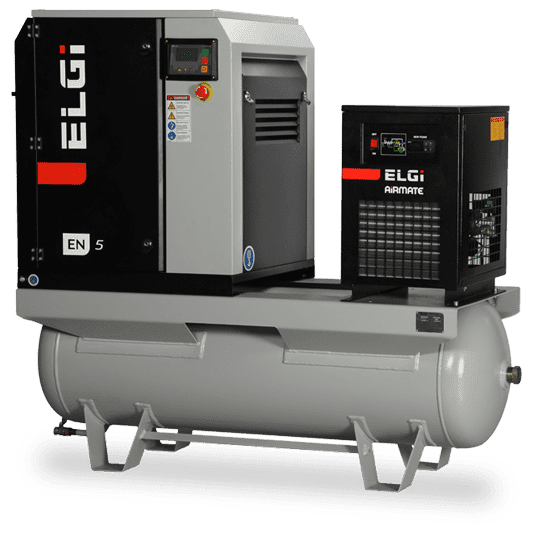WHAT IS THE WORKING PRINCIPLE OF THE ROTARY SCREW AIR COMPRESSOR? The Screw air compressor uses a rotary-type positive-displacement mechanism. The screw element consists of two rotors similar to a helix, each with a different shape and number of grooves/ teeth. Atmospheric air moves into the screw element, and as the air progresses along with the rotors, it gets compressed. The main characteristic of the screw compressor is a male and female rotor element that traps the air and compresses it as the volume reduces inside the airend gradually. The compressed air is released at the delivery end. In an oil-injected rotary screw compressor, a thin film of lubricating oil ensures frictionless rotation. The oil also acts as a cooling medium as it carries away heat energy during the compression process. This oil is cooled in a heat exchanger before it re-enters the airend. In an oil-free rotary screw type air compressor, a special coating on the rotors acts as a lubricating medium and helps dissipate the heat energy. No oil enters the airend which ensures a 100% oil-free air output. The basic principle of a rotary-type screw air compressor is that the male and female rotors spin in opposite directions. The prime mover turns the rotor of the airend in a rotary screw air compressor. This develops a vacuum, which results in surrounding air being driven into the airends through the air filter. As the rotors turn progressively, air gets trapped in the spaces between the two screws (rotors). Air is taken from the atmosphere and pumped into the rotary screw compressor through the air intake system. First, it passes through a filter that helps remove suspended particles from it. Next, the filtered air goes into the airend, which is the heart of the rotary screw air compressor. Here, the air is trapped within the spaces between the two rotors, with lobes that mesh with each other. As the rotors turn, they progressively compress the trapped pockets of air, discharging the compressed air at the outlet of the airend. ELGi’s EN & EG series are good examples of best-in-class rotary screw electric air compressor technology.
Chat with us on WhatsApp
×
This is your website preview.
Currently it only shows your basic business info. Start adding relevant business details such as description, images and products or services to gain your customers attention by using Boost 360 android app / iOS App / web portal.

2024-05-16T11:28:48
WHAT IS THE WORKING PRINCIPLE OF THE ROTARY SCREW AIR COMPRESSOR? The Screw air compressor uses a rotary-type positive-displacement mechanism. The screw element consists of two rotors similar to a helix, each with a different shape and number of grooves/ teeth. Atmospheric air moves into the screw element, and as the air progresses along with the rotors, it gets compressed. The main characteristic of the screw compressor is a male and female rotor element that traps the air and compresses it as the volume reduces inside the airend gradually. The compressed air is released at the delivery end. In an oil-injected rotary screw compressor, a thin film of lubricating oil ensures frictionless rotation. The oil also acts as a cooling medium as it carries away heat energy during the compression process. This oil is cooled in a heat exchanger before it re-enters the airend. In an oil-free rotary screw type air compressor, a special coating on the rotors acts as a lubricating medium and helps dissipate the heat energy. No oil enters the airend which ensures a 100% oil-free air output. The basic principle of a rotary-type screw air compressor is that the male and female rotors spin in opposite directions. The prime mover turns the rotor of the airend in a rotary screw air compressor. This develops a vacuum, which results in surrounding air being driven into the airends through the air filter. As the rotors turn progressively, air gets trapped in the spaces between the two screws (rotors). Air is taken from the atmosphere and pumped into the rotary screw compressor through the air intake system. First, it passes through a filter that helps remove suspended particles from it. Next, the filtered air goes into the airend, which is the heart of the rotary screw air compressor. Here, the air is trapped within the spaces between the two rotors, with lobes that mesh with each other. As the rotors turn, they progressively compress the trapped pockets of air, discharging the compressed air at the outlet of the airend. ELGi’s EN & EG series are good examples of best-in-class rotary screw electric air compressor technology.
2024-05-16T11:28:48
Keywords
- ELGi
- heart
- helix
- lobes
- airend
- number
- outlet
- volume
- spaces
- vacuum
- pockets
- EG series
- particles
- suspended
- thin film
- two screws
- air filter
- two rotors
- atmosphere
- heat energy
- prime mover
- delivery end
- screw element
- good examples
- female rotors
- cooling medium
- grooves/ teeth
- heat exchanger
- compressed air
- special coating
- basic principle
- different shape
- surrounding air
- Atmospheric air
- WORKING PRINCIPLE
- air intake system
- lubricating medium
- compression process
- main characteristic
- opposite directions
- female rotor element
- frictionless rotation
- 100% oil-free air output
- The Screw air compressor
- ROTARY SCREW AIR COMPRESSOR
- rotary-type screw air compressor
- injected rotary screw compressor
- oil-free rotary screw type air compressor
- rotary-type positive-displacement mechanism
- class rotary screw electric air compressor technology

Submit Your Enquiry